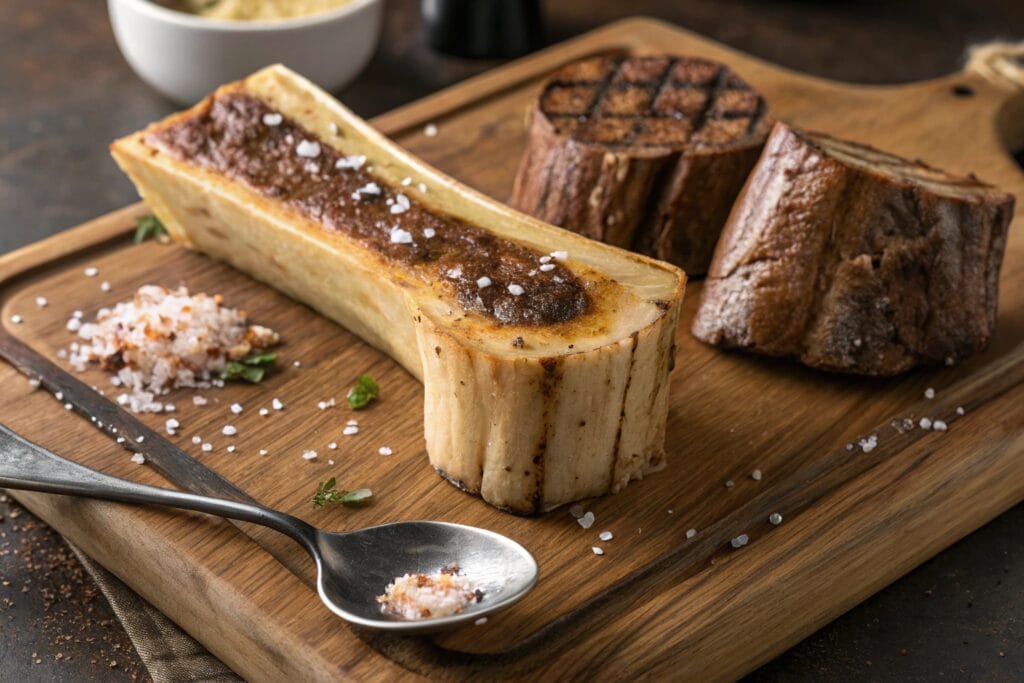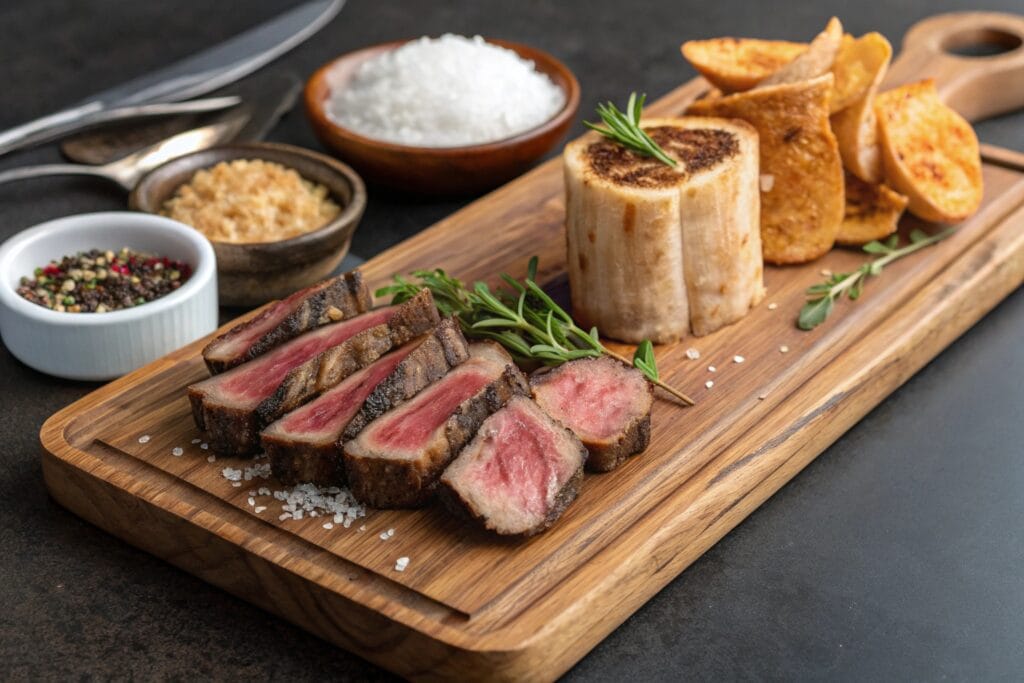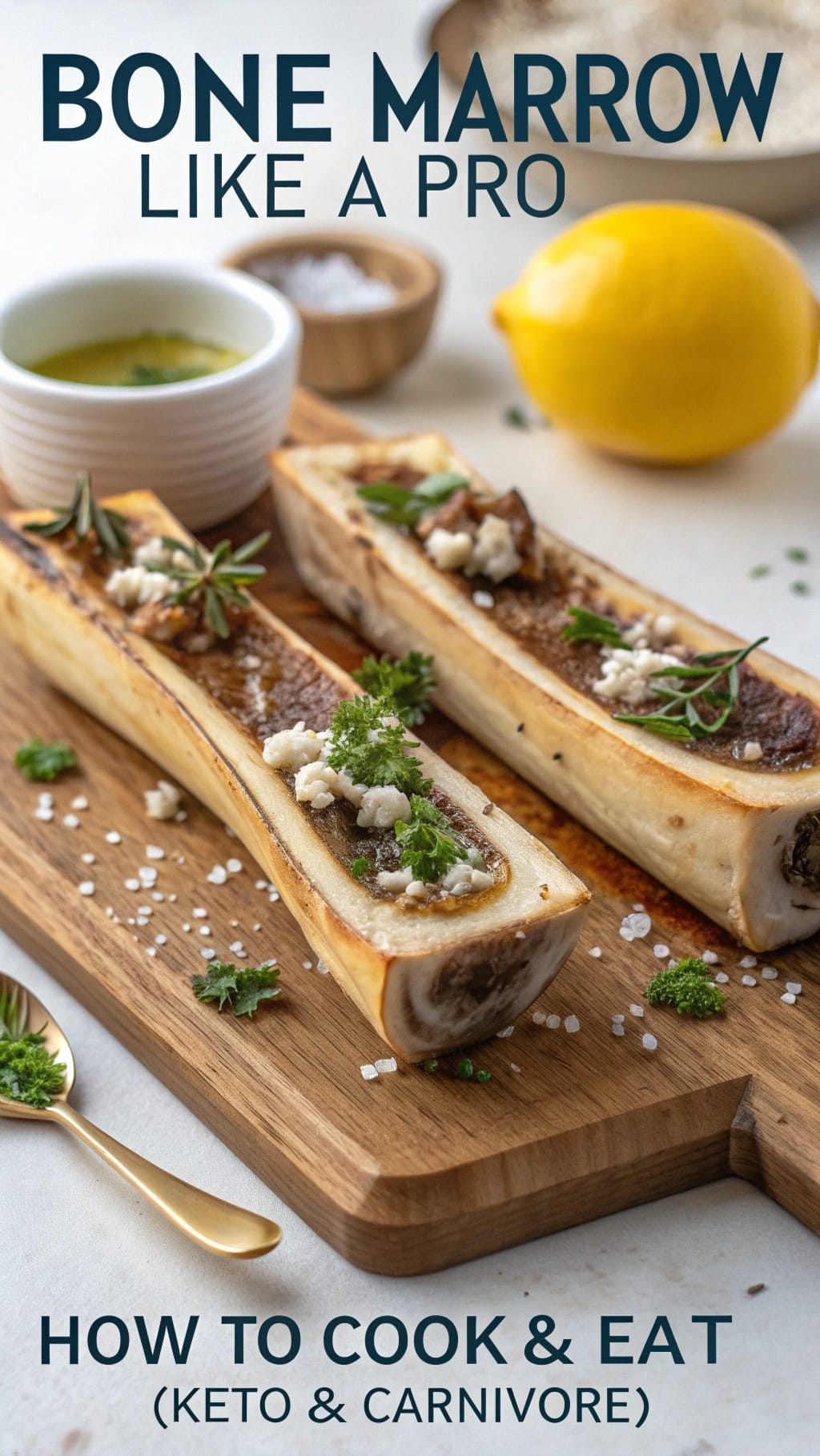How to Cook & Eat Bone Marrow Like a Pro (Keto + Carnivore Friendly)
Are you curious about that rich, buttery delicacy hidden inside beef bones that carnivore and keto enthusiasts can’t stop raving about? Bone marrow might seem intimidating at first glance, but this nutrient-dense ancestral superfood is not only incredibly nutritious but also surprisingly simple to prepare.
Many people feel uncertain when faced with these prehistoric-looking bones at the butcher counter. How exactly do you cook them? What does bone marrow taste like? And what’s the proper way to eat it once it’s prepared?
This comprehensive guide will demystify bone marrow completely, showing you just how easy it is to prepare (especially roasted) and enjoy this delicious keto and carnivore-friendly delicacy. By the end, you’ll be cooking and eating bone marrow like you’ve been doing it your whole life!
Table of Contents

What is Bone Marrow & Why Eat It on Keto/Carnivore? (The Benefits)
Bone marrow is the soft, fatty tissue found inside animal bones, particularly in the hollow centers of long bones like femurs. This ancestral superfood has been prized by traditional cultures worldwide for thousands of years – and for good reason.
Nutritional Powerhouse
Bone marrow is one of the most nutrient-dense foods you can include in your keto or carnivore diet, offering an impressive array of beneficial compounds:
- Healthy Fats: Bone marrow is approximately 97% fat, making it an excellent energy source for keto and carnivore dieters. It contains a mix of saturated, monounsaturated, and polyunsaturated fats that provide clean, sustained energy.
- Vitamins: Rich in fat-soluble vitamins including A, E, and the often-overlooked vitamin K2, which plays a crucial role in bone health and cardiovascular function. It also contains small amounts of B vitamins.
- Minerals: Contains phosphorus, calcium, and other trace minerals that support overall health.
- Collagen Precursors & Alkylglycerols (AKGs): Bone marrow contains compounds that support immune function and cellular health. Research suggests that AKGs may help support healthy cell production and immune system regulation.
According to a study published in the American Journal of Clinical Nutrition, traditional animal-based foods like bone marrow provide essential nutrients that are difficult to obtain from other dietary sources.
Taste & Texture
The flavor profile of bone marrow is uniquely delicious – rich, buttery, and slightly sweet with a subtle umami quality. The texture is velvety and creamy when properly cooked, similar to softened butter but with more complexity. Many describe it as “meat butter” because of its luxurious mouthfeel and rich flavor.
Why it Fits Keto/Carnivore Perfectly
Bone marrow is essentially the perfect keto and carnivore food for several reasons:
- High Fat Content: With virtually zero carbohydrates and approximately 97% fat content, it’s ideal for maintaining ketosis.
- Nutrient Density: Provides fat-soluble vitamins and minerals that complement muscle meat consumption.
- Nose-to-Tail Philosophy: Embraces the ancestral practice of using the entire animal, reducing waste and maximizing nutritional benefits.
- Zero Carbs: Contains no carbohydrates, making it perfect for strict carnivore dieters.
Choosing the Right Bones for Marrow
Selecting the right bones is the first step to enjoying perfect bone marrow. Not all bones are created equal when it comes to extracting this nutritional gold.
Best Bones
The femur bones (leg bones) from beef are widely considered the best source of bone marrow. These large bones contain the most abundant and accessible marrow. Look for bones cut in one of two ways:
- Canoe Cut: Also called “split bone” – these are femur bones cut lengthwise, exposing the marrow along the entire length. This is the ideal cut for roasting and serving since it provides easy access to the marrow.
- Center Cut / Cross Cut: These are femur bones cut crosswise into 2-3 inch sections. The marrow appears as a circle in the center. These work well too, though accessing the marrow requires a small spoon or knife.
Source
For optimal nutrition and taste, choose bones from grass-fed and grass-finished beef whenever possible. Research published in the Journal of Animal Science indicates that grass-fed animals typically have higher levels of omega-3 fatty acids and certain vitamins compared to grain-fed counterparts.
Where to Buy
Quality bone marrow bones can be found at:
- Local butcher shops
- Farmers markets
- Online specialty meat suppliers focusing on grass-fed products
- Well-stocked grocery stores (often labeled as “soup bones” in the meat section)
Many butchers will cut the bones to your specifications if you ask. Don’t be shy about requesting canoe cuts specifically for roasting marrow.

How to Cook Bone Marrow: The Roasting Method (Easiest & Best)
While there are several ways to prepare bone marrow, roasting is by far the most popular method among chefs and home cooks alike. Roasting intensifies the flavor, creates the perfect texture, and is incredibly simple.
Why Roasting?
Roasting bone marrow at high heat brings out its rich, buttery flavor while creating the perfect soft, spreadable consistency. The dry heat of the oven caramelizes the exposed surface slightly, enhancing the taste without requiring any additional ingredients.
Optional Pre-Soak
Some chefs recommend soaking marrow bones in cold salted water for 12-24 hours before cooking. This step helps draw out any residual blood and impurities, resulting in a cleaner-tasting final product.
If you choose to soak:
- Submerge bones in cold water with 1-2 tablespoons of salt
- Refrigerate for 12-24 hours
- Rinse thoroughly and pat dry before roasting
This step is entirely optional, especially if you’re working with high-quality bones. Many carnivore purists skip the soaking step entirely.
Step-by-Step Roasting Instructions
- Preheat Oven: Set your oven to 425°F (220°C) – this high temperature ensures proper rendering without completely melting the marrow.
- Prepare Bones:
- For canoe cut bones: Place them on a baking sheet, marrow side up
- For center cut bones: Stand them upright on a baking sheet
- Consider lining your baking sheet with foil or parchment for easier cleanup, as some fat may render out
- Seasoning (Simple is Key!):
- Sprinkle generously with high-quality salt (sea salt or Himalayan salt works wonderfully)
- Optional: Add freshly ground black pepper (note: strict carnivore dieters may skip pepper)
- Nothing else is needed! The natural flavor of bone marrow shines on its own
- Roasting Time:
- Small/medium bones: 15-20 minutes
- Large bones: 20-25 minutes
- The exact time will depend on your oven and the size of the bones
- How to Tell When It’s Done:
- Properly cooked marrow will be hot throughout
- It will appear slightly bubbling at the edges
- The marrow will have pulled away slightly from the bone
- It should be soft and jiggly, similar to warm butter
- IMPORTANT: Do not overcook! If the marrow completely melts and runs out of the bone, it’s overdone
Resting
Allow the roasted bones to rest for 3-5 minutes after removing from the oven. This helps the marrow set to the perfect consistency and prevents burning your mouth (the inside gets extremely hot!).
How to Eat Roasted Bone Marrow (Serving Suggestions)
Now comes the fun part – enjoying your perfectly roasted bone marrow! There are several delicious ways to savor this nutrient-dense treat.
The Classic Way
The traditional method of eating bone marrow:
- Use a small spoon or narrow butter knife to scoop the marrow from the bone.
- Spread the warm marrow directly onto:
- Slices of cooked steak or roast (the perfect carnivore serving method!)
- Burger patties without the bun
- Pork rinds or chicharrones (excellent keto/carnivore-friendly “crackers”)
For those following less restrictive diets, bone marrow is traditionally spread on toast points, but we’ll focus on keto and carnivore-friendly options here.
Scoop and Enjoy
Many bone marrow enthusiasts prefer to simply scoop it directly from the bone and eat it with a sprinkle of salt. This “purist” approach lets you fully appreciate the rich, buttery flavor and silky texture without any distractions.
Mix into Dishes
Bone marrow can also be incorporated into other carnivore or keto dishes:
- Stir into ground beef while cooking for added richness
- Mix into scrambled eggs for a luxurious breakfast
- Use as a finishing “butter” on a hot steak
- Blend into carnivore meat stock for extra richness
Flavor Pairings
While bone marrow is delicious with just salt, those on a more flexible keto diet might enjoy these complementary flavors:
- A squeeze of fresh lemon juice (adds brightness to cut through the richness)
- A sprinkle of fresh herbs like parsley (traditional in the classic French dish “Os à Moelle”)
For strict carnivore dieters, simply enjoy with salt for a pure experience.
Tips for Bone Marrow Success
Follow these simple tips to ensure bone marrow perfection every time:
Don’t Overcook
The biggest mistake people make when cooking bone marrow is leaving it in the oven too long. Once overcooked, the marrow completely liquefies and runs out of the bone. Watch carefully, especially the first few times you prepare it. Remember: you want it soft and jiggly, not completely melted.
Buy Quality Bones
The quality of your bones significantly impacts the flavor and nutritional profile of the marrow. Whenever possible, choose bones from grass-fed, pasture-raised animals for the best taste and nutrition.
Season Simply
Let the natural flavor of bone marrow shine. Unlike many other foods, bone marrow doesn’t need complex seasonings or marinades – quality salt is all you really need.
Serve Immediately
Bone marrow is at its peak when served hot from the oven (after a brief rest). The texture and flavor are optimal when warm, so plan your meal timing accordingly.
Storing Leftover Marrow/Bones
Cooked Marrow
If you have leftover cooked marrow:
- Scoop it from the bones while still warm
- Store in an airtight container in the refrigerator
- Use within 3-4 days
- The marrow will solidify when cold and can be used like butter
- Gently reheat if desired, or use cold as a spread
Spent Bones
Don’t throw away those bones after you’ve enjoyed the marrow! They’re perfect for making nutrient-rich bone broth. Save them in a freezer bag until you have enough to make your next batch of beef bone broth.
Combining marrow bones with joint bones creates an especially nutritious broth for carnivore bone broth recipes that can support gut health and provide additional minerals.

Frequently Asked Questions About Bone Marrow
Is bone marrow healthy to eat?
Yes, bone marrow is extremely healthy and nutrient-dense. It’s rich in healthy fats, fat-soluble vitamins (A, K2, E), minerals, and compounds that support immune function. For those on keto or carnivore diets, it’s an excellent source of quality fats with zero carbohydrates. Ancestral cultures have prized bone marrow for thousands of years for its nutritional benefits.
How can you tell when bone marrow is cooked?
Properly cooked bone marrow should be hot throughout, slightly bubbling at the edges, and have pulled away slightly from the bone. It should have a soft, jiggly consistency similar to warm butter. If the marrow completely liquefies and runs out of the bone, it’s overcooked. Most marrow bones will be perfectly roasted after 15-25 minutes at 425°F (220°C), depending on their size.
What does bone marrow taste like?
Bone marrow has a rich, buttery flavor with subtle sweetness and umami notes. Many describe it as “meat butter” because of its luxurious, silky texture and rich taste. The flavor is delicate yet distinct, with a pleasant fatty quality that melts in your mouth. When properly seasoned with just salt, the natural flavors shine through perfectly.
Is bone marrow keto and carnivore friendly?
Absolutely! Bone marrow is ideal for both keto and carnivore diets because it contains approximately 97% fat and zero carbohydrates. It’s a perfect high-fat food that supports ketosis while providing valuable nutrients. On carnivore diets, bone marrow fits the animal-based paradigm perfectly and aligns with the nose-to-tail eating philosophy.
Where can I buy bones for bone marrow?
Quality beef marrow bones can be purchased from local butcher shops, farmers markets, online specialty meat suppliers focusing on grass-fed products, and even well-stocked grocery stores (where they’re often labeled as “soup bones”). For the best eating experience, ask your butcher for “canoe cut” marrow bones, which are cut lengthwise to expose the marrow and make it easier to access after cooking.
Conclusion
Bone marrow is truly one of nature’s perfect foods for those following carnivore or keto lifestyles. This nutrient-dense, fat-rich delicacy offers incredible flavor and nutrition with minimal preparation. The simple roasting method described here lets you enjoy this ancestral superfood with very little effort.
Whether you’re spreading it on steak, scooping it straight from the bone, or using it to enrich other dishes, bone marrow deserves a regular place in your carnivore or keto meal rotation. Don’t be intimidated by those prehistoric-looking bones – they hold one of the most delicious and nutritious foods you can eat!
Have you tried bone marrow? What’s your favorite way to enjoy this nutrient-dense food? Share your experiences in the comments below!
Related Articles:
- Carnivore Diet: Complete Beginner’s Guide
- Top Carnivore Diet Benefits 2025
- Animal Based Diet: The Ultimate Guide
- Carnivore Diet Supplements: What You Need to Know
- Zero Carb Snacks for Keto & Carnivore
References:
- Cordain L, et al. “Origins and evolution of the Western diet: health implications for the 21st century.” American Journal of Clinical Nutrition.
- Daley CA, et al. “A review of fatty acid profiles and antioxidant content in grass-fed and grain-fed beef.” Nutrition Journal.
- Williams P. “Nutritional composition of red meat.” Nutrition & Dietetics.
- Loren Cordain. “The Paleo Diet: Lose Weight and Get Healthy by Eating the Foods You Were Designed to Eat.“
Enjoy, Review – We Value Your Opinion!
There are no reviews yet. Be the first one to write one.

